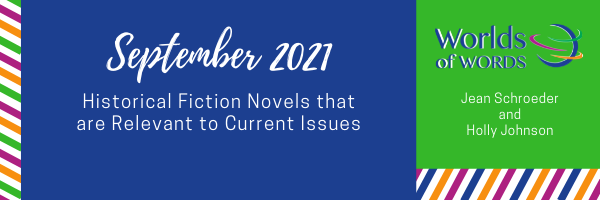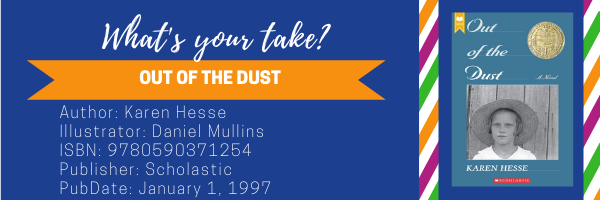By Jean Schroeder, The IDEA School, Tucson, AZ, and Holly Johnson, University of Cincinnati, Cincinnati, OH
This month we wanted to ponder four pieces of historical fiction that are relevant to current issues. In doing so, we wanted to also revisit two novels that we consider classic novels while also introducing a couple of newer books that we found to be incredible reads. Many times, these incredible reads are books that present situations, places, or events we don’t quite want to “leave” for any number of reasons. They are, in essence, those that continue to haunt or delight long after the last page.
This month we start with the classic, Out of the Dust (1997) by Karen Hesse, and then turn to Brother’s Keeper (2020) by Julie Lee. For week three, we will highlight Mildred D. Taylor’s Mississippi Bridge (1992), and end with Just Like That (2021) by Gary D. Schmidt. These four novels deliver stories that are not only powerful and long-lasting individually, but are relevant parts of longer conversations addressing displacement, gender, the environment, race, struggle, and advocacy. All in all, they are remarkable.
JEAN: With all the current realizations surrounding climate change, Out of the Dust puts us in the heart of a climate phenomenon – the Dust Bowl. Set in Oklahoma in the 1934-35, 14-year-old Billie Jo opens a window into to her family life and their struggle to survive. They live in a small farming community where wheat has been what sustains most of the farm families. But now they are plagued by the on slot of massive dust storms, some lasting days. “…the dust came/ tearing up fields where winter wheat, /set for harvest in June, / stood helpless.” (p.31). In verse, Karen Hesse narrates the story of the constant, day after day, and hour after hour fight against the dust as it settled on their treasures, on their dishes, on their clothes, on their food. It clogged their cars, trucks and tractors, suffocated the animals and caused dust pneumonia in their friends. When Pa accidentally leaves a pail of kerosene near the stove both Ma and Billie Jo suffer burns when it catches fire. The injuries take the lives of Billie Jo’s Ma and her newborn baby brother and badly burned Billie Jo’s hands—her piano hands. The family now consisted of Billie Jo and her father. Both grieve deeply for Ma and they find themselves alone in their grief and in their living.
The story is beautifully told with descriptions of the dust, the events, and the emotions that put you in the storms or seat you at the dinner table. “…heaven’s shadow crept across the plains, / a black cloud, / big and silent as Montana, / boiling on the horizon and / barreling toward us.” I felt the exhaustion of hanging on and living through their experiences. Billie Jo just wanted out, out of the dust. She watched others leave for greener pastures with envy. The simplicity of the verse style belies the complexity of life and emotion. I was caught off guard whenever they referred to the river. While rain was absent, water was not. I had to wrap my desert thinking around that! I was interested in how long it took for Pa to consider the changes Ma had suggested. People are so averse to change, and do so much denying before considering change or acceptance. This book was just as powerful, if not more so, when I read it now as it was in 1997! I have to think this is in part due to the emphasis on climate change and the global environment. What stands out for you in this read, Holly? How do you see this story fitting in today’s environmental context?
HOLLY: As I listen to the news, Jean, I cannot help but think about the conditions of the Dust Bowl and the current drought and fires in the West. And I find myself wondering, “How long?” How long will these conditions last? Will it take extraordinary actions by human beings or can nature “correct” this imbalance? Before you think I don’t have real issues how human beings need to cease and desist when it come to the environment and the abuses it has endured, I am really asking if this change we see in the West is permanent or if we stop some of our abuses, can nature correct the damage? I am pretty sure those who lived in the Dust Bowl areas asked themselves similar questions. And I imagine those who stayed in their towns and homes did so because they believed it wasn’t permanent change. How much damage have we done now, and can any government program intervene?
The Dust Bowl lasted for six years, and the Great Depression was around the same time! People are so resilient, which is a theme that makes it way through these books this month, now that I think about it. I loved this read when it first came out, and like you, love it now. The time period stirs my imagination, as does the representation of people who endured, who survived, who held on.
Billie Jo is such a strong character, but her strength is revealed in times of what some might consider weakness. How often does that seem to be the case? I also love the way the book is written, so powerful, and the stanzas won’t allow readers to ignore the emotions, actions, situations, and results of the time period and what Billie Jo and her father experienced. Out of the Dust is a great example of how literature allows readers to “witness” history, as perhaps consider the ways they are witnesses to current situations.
JEAN: You reminded me of something else—government programs. There were some active as the text indicates, but it doesn’t tell us about the fact that Congress truly did not take much interest in the Dust Bowl until one of those storms actually enveloped Washington D.C., and the politicians came into contact with what farming communities were regularly experiencing.
Another theme in this story I found pertinent is music. While it is primarily in the background, as music often is, it is also in the forefront reminding me how important music is in our lives. The piano in this book represents so many things: pleasure, entertainment, escape, hope. It is life affirming. As I read this book I found myself taking on the sadness and hopelessness the characters were feeling. But the ending left me feeling the hope of rain and change and growth. This in turn put me in a mindset of loving this book.
When I used this book with undergraduates many had never heard of the Dust Bowl. I am guessing that is as true today as then since the undergrads would be even more removed historically, and it is an event that does not show up in history texts. When I showed a video to one to my classes, they were stunned. What I never could figure out is whether to show the video before or after reading the book. This story is impactful.
HOLLY: Your comment about the politicians in Washington resonates, Jean, as does the idea that the USA is so large, that I can see how we could wonder if people are concerned about a geographical area so “far” from their own. Yet, as we continue to experience climate change on a global level, I believe what is happening far from our own homes matters more and more. And it is beginning to matter to more and more people. The setting of Out of the Dust is still so relevant as we continue to think about our environment, and even what we can do about the damage already done. I think this book also suggests a bit of humility is needed when it comes to change and that humility might just lead to hope. Billie Jo and her father stay, and in staying are determined to stay in the place they love in spite of changes. That is hope manifested in action. I love this novel as well.
Title: Out of the Dust
Author: Karen Hesse
Illustrator: Daniel Mullins
ISBN: 9780590371254
Publisher: Scholastic
PubDate: January 1, 1997
Throughout Spetember 2021, Jean Schroeder and Holly Johnson discuss four historical fiction novels that are relevant to today’s issues. Check back each Wednesday to follow the conversation!
- Themes: Holly Johnson, Jean Schroeder, Karen Hesse, Out of the Dust
- Descriptors: Books & Resources, My Take/Your Take


